How cheap can rockets get? It’s an important question to answer for grokking the future of humanity in space. Soon rockets will be as easy to fly as aircraft and costs are going to get so low that we’ll be flying to Mars as easily as we fly across the ocean. Right?
Let’s do a little thought experiment. Imagine a hypothetical launch vehicle, the Enterprise 8. Enterprise 8 is an expendable two stage vehicle and can put about 12,000 kg into LEO. It burns about 300,000 kg of liquid oxygen (LOx) and about 110,000 kg of kerosene (RP1). Generic early 2020s rocket.
The cost per kg to put stuff into space is roughly a function of 3 things. The first is the Infrastructure Cost, i.e. the cost of all the infrastructure on the ground to make our space launch operation work. This includes stuff like engineers, technicians, security guards, HR, custodians, and all the factories, launch sites, and recovery ships they work in. The second is the Hardware Cost, the cost of the Enterprise 8 itself. Lastly there is the Propellant Cost, the cost of the propellant that is burned every launch.
Let’s assume an annual Infrastructure cost of $750M/yr. I could explain how I came up with this number but it is a bit wonky, tedious, and best saved for an appendix, go check it out if you really feel like it. A rocket like Enterprise 8 is expected to have a booster cost of about $20M/unit and an upper stage cost of about $10M/unit. The government publishes the price of rocket fuel, so with that let’s get number crunchin.
First let’s look at the fully expendable version of Enterprise 8. Using the assumptions above we can plot $/kg as a function of flight rate, the # of times we launch Enterprise 8 per year.
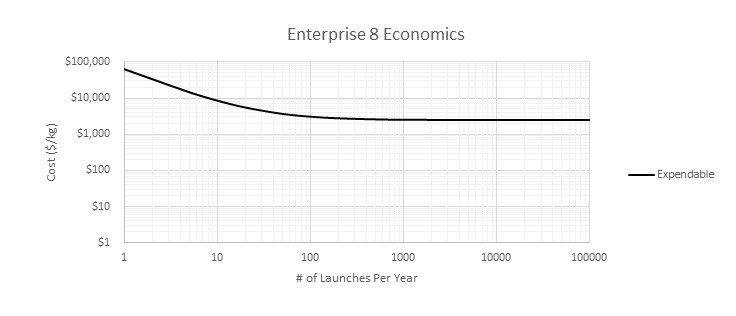
The shape of this curve is important. See how costs start off super high when launch rate is low and then logarithmically decrease as flight rate increases? There is a saying in economics, given infinite time all fixed costs go to zero; the more we fly Enterprise 8 the better we can spread out the Infrastructure Cost. Fly often enough and the Infrastructure Cost contribution is functionally zero. At this point the cost to fly the rocket is effectively the marginal cost to build a new rocket and fuel it up. As long as Enterprise 8 consumes the same amount of fuel and remains expendable, $2500/kg is the best this vehicle ever gets.
Undeterred we task the boffins at our fictional launch company to modify Enterprise 8’s booster stage into being reusable. Let’s say we’re able to make a version that can be reused up to 20 times or so.
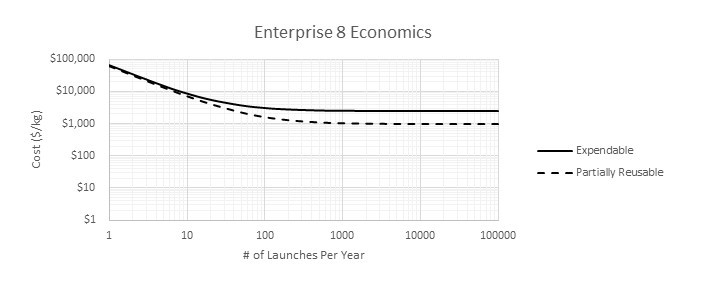
Reusing the booster knocks about 60% off the cost of the launch. This partially reusable Enterprise 8 can achieve about $1000/kg. But why stop at only 20 reuses per booster, what if we did more?
Turns out it doesn’t really matter. I plotted the impact of # of reuses on the cost of the rocket.
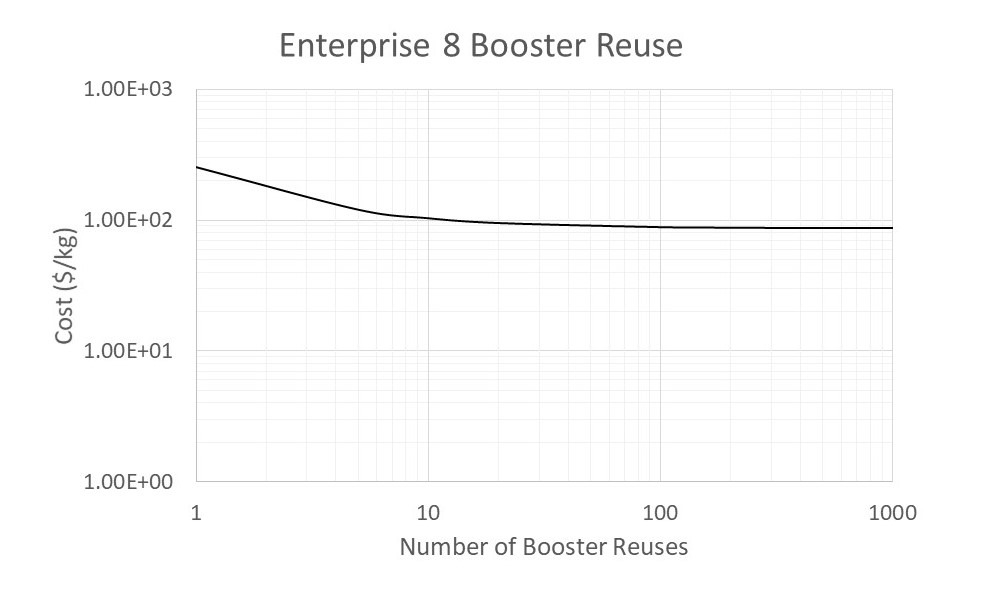
More reuses never hurts, but each takes a smaller and smaller part of the cost away, and thus each additional reuse has less benefit to cost. With many reuses, the best best partially reusable Enterprise 8 can do is about ~$900/kg.
Mars in our sights we decide to go big or go home with a fully reusable launch vehicle, Battlestar. Battlestar is going to be a beast of a rocket. It can put about 100,000 kg of payload into orbit. It costs about $300M to build and can be reused thousands of times, just like an airliner. It requires about 4 million kg of LOx and 1 million kg of natural gas.
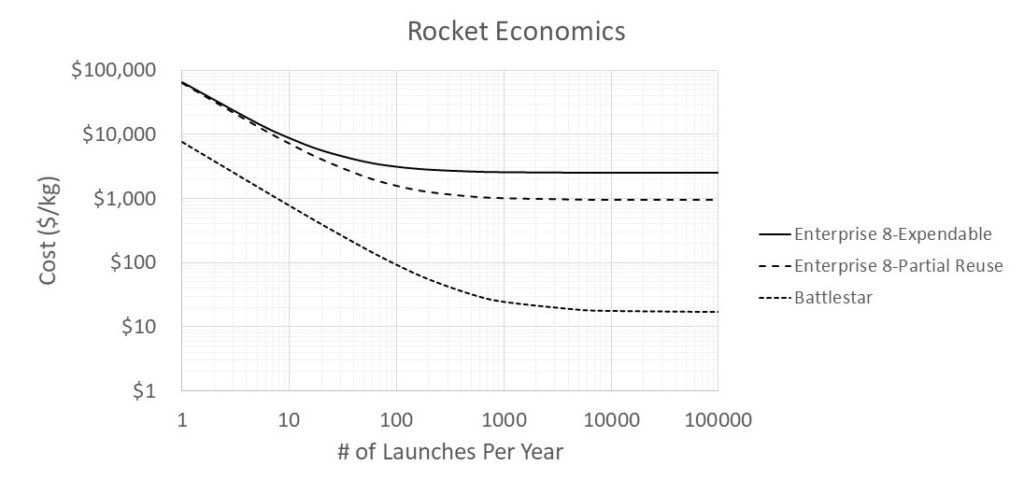
Holy moly, $17/kg! That’s a 98% cost reduction over Enterprise 8! By reusing both stages, Battlestar is able to reach a point where the marginal launch cost if basically the cost to fuel it up.
This is a number worth advertising. But it’s worth noting it takes about 2,000 flights a year to get to that point. If only 100 flights a year are launched, costs are still more like $500/kg. Still a 50% reduction over Enterprise 8.
Enterprise 8 and Battlestar are simplified approximations of vehicles like Falcon 9 and Starship but they serve to illustrate what is possible with chemical rockets. A 100x reduction in the cost of launch is totally possible and may even be unlocked with vehicles being built today. The day may soon come where we see rockets as just another mundane transportation system. For terrestrial logistics we tend to compare various modes of transport by their cost per ton mile. This is roughly correlated to the energy efficiency and hence the fuel consumption of the vehicle. How do rockets stack up?
To try and make this an apples to apples comparison we need a terrestrial benchmark to compare the rocket against. I am going to pick a totally arbitrary distance of 6000 km, about the difference from Europe to North America. The space community loves to make comparisons between space exploration and the European conquest of the Americas. It’s time to put our money where our collective mouths are and see if there’s any truth to this.
The table below puts rockets on a continuum with other transportation systems.
| Mode of Transport | Cost ($/kg) |
| Ship-Transatlantic1 | $0.13 |
| Airplane-Transatlantic2 | $7.00 |
| Helicopter-Transatlantic | $17.00 |
| Battlestar-LEO | $17.00 |
| Battlestar-Lunar | $85.00 |
| Battlestar-Mars | $153.00 |
- Ship data from bureau of transportation statistics. ↩︎
- Airplane & Helicopter data from Straightline Aviation ↩︎
So there you have it, using a vehicle like Battlestar to get to LEO is like trying to cross the ocean in a helicopter. Launching tankers to refuel Battlestar so it can go on to the Moon or Mars would be like sending a flotilla of helicopters to the east coast, using them to fill the tanks of a single helicopter in NYC, and flying that helicopter onward to California. Definitely more involved than the Mayflower.
If you want to get a feeling for what space infrastructure may look like, go look at a place where helicopters are effectively the only means of transportation. The list is not large; isolated mountain top basecamps and outposts. These are places where the high cost of helicopter transport is worth it because there’s just no other way to get material up there. These huts and bivouacs are modest. If you want to build on a mountaintop, most of your budget is still going to transport, not the building itself. Despite these constraints humanity has slowly established a presence at the top of the world. It’s nowhere near as big as European colonies in North America or even the bases of Antarctica, but it’s still home to hundreds of people living, working, and thriving in a hostile environment. There’s no reason space can’t be our next mountaintop.
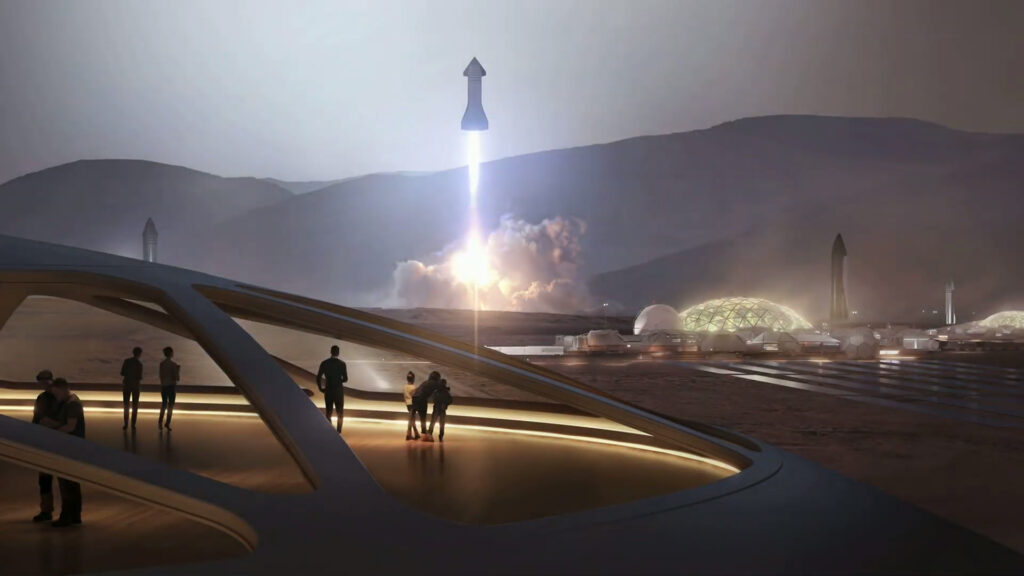

Photos courtesy of SpaceX and Chamonix Mont-Blanc Hélicoptères
Appendix: How I Came Up With the Infrastructure Cost
Welcome, glad you made it down here. Good on you for wanting to know more. I got to the $750M number by shamelessly copying a methodology from Jonathan Goff. Selenian Boondocks is one of the great space blogs in its own right and is a huge inspiration for what I am trying to do with Spaceships. Anyhoo, Jon’s approach is to assume a headcount for our hypothetical launch company. For this post I assumed 2000 employees, about the size of Relativity Space or United Launch Alliance. Other space companies are larger but they have their fingers involved in many other things than launch. We’re going to assume that each employee carries a burdened cost of $250K/year. This represents their salary and benefits. Assume a further 50% in overhead to account for all the facilities and administrative roles.
$750M/yr is somewhat in the ballpark for large space transportation programs. Recent public statements from Elon Musk indicate that the Starship program has an annual cost of around $1B-$2B/year. This is for a very ambitious and fast paced R&D program. Typically engineering costs go down after the rocket is flying as development engineers are assigned to other programs, leaving behind a smaller pool of production and operations staff.

One thought on “How Cheap Can Rockets Get?”